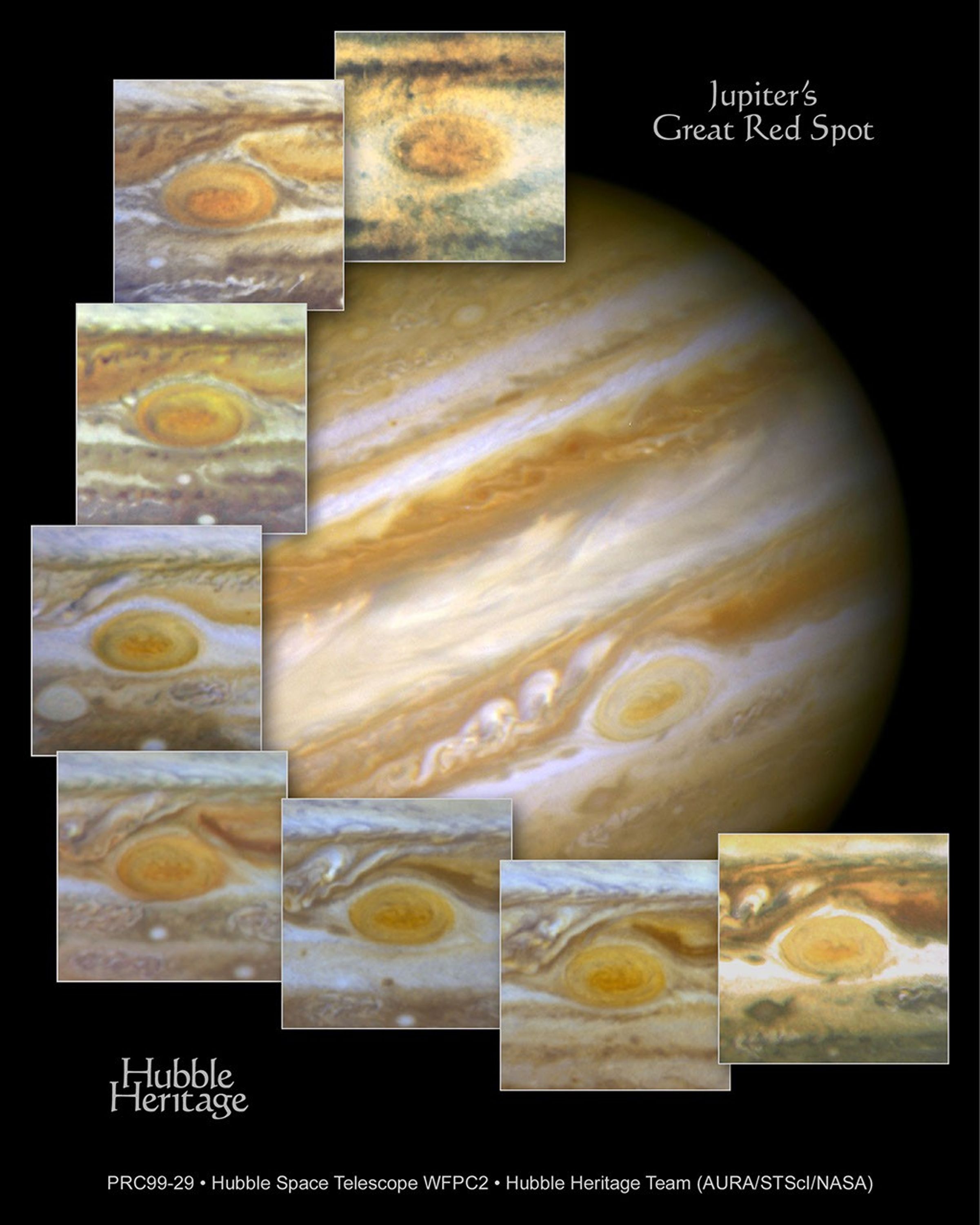1 min read
The Great Red Spot: An Ancient Storm in Jupiter’s Atmosphere

When 17th-century astronomers first turned their telescopes to Jupiter, they noted a conspicuous reddish spot on the giant planet. This Great Red Spot is still present in Jupiter's atmosphere, more than 300 years later. It is now known that it is a vast storm, spinning like a cyclone. Unlike a low-pressure hurricane in the Caribbean Sea, however, the Red Spot rotates in a counterclockwise direction in the southern hemisphere, showing that it is a high-pressure system. Winds inside this Jovian storm reach speeds of about 270 mph.
The Red Spot is the largest known storm in the Solar System. With a diameter of 15,400 miles, it is almost twice the size of the entire Earth and one-sixth the diameter of Jupiter itself.
The long lifetime of the Red Spot may be due to the fact that Jupiter is mainly a gaseous planet. It possibly has liquid layers, but lacks a solid surface, which would dissipate the storm's energy, much as happens when a hurricane makes landfall on the Earth. However, the Red Spot does change its shape, size, and color, sometimes dramatically. Such changes are demonstrated in high-resolution Wide Field and Planetary Cameras 1 & 2 images of Jupiter obtained by NASA's Hubble Space Telescope, and presented here by the Hubble Heritage Project team. The mosaic presents a series of pictures of the Red Spot obtained by Hubble between 1992 and 1999.
Astronomers study weather phenomena on other planets in order to gain a greater understanding of our own Earth's climate. Lacking a solid surface, Jupiter provides us with a laboratory experiment for observing weather phenomena under very different conditions than those prevailing on Earth. This knowledge can also be applied to places in the Earth's atmosphere that are over deep oceans, making them more similar to Jupiter's deep atmosphere.
The Hubble images were originally collected by Amy Simon (Cornell U.), Reta Beebe (NMSU), Heidi Hammel (Space Science Institute, MIT), and their collaborators, and have been prepared for presentation by the Hubble Heritage Team.
About the Object
- DistanceDistanceThe physical distance from Earth to the astronomical object. Distances within our solar system are usually measured in Astronomical Units (AU). Distances between stars are usually measured in light-years. Interstellar distances can also be measured in parsecs.5.2 Astronomical Units (778 million km or 483 million miles )
- DimensionsDimensionsThe physical size of the object or the apparent angle it subtends on the sky.142,984 km or 88,789 miles (at equator). Diameter of Great Red Spot: 24,800 km or 15,400 miles (lengthwise). Visual Magnitude: -2.6 magnitude (at opposition)
About the Data
- Data DescriptionData DescriptionProposal: A description of the observations, their scientific justification, and the links to the data available in the science archive.
Science Team: The astronomers who planned the observations and analyzed the data. "PI" refers to the Principal Investigator.Principal Astronomers: A. Simon (Cornell U.), R. Beebe (NMSU), and collaborators, H. B. Hammel (Space Science Institute, MIT), R. Beebe (NMSU), J. T. Clarke (U. Michigan) , R. A. West (JPL), A. Storrs (STScI), and collaborators, H. Bond, C. Christian, J. English, L. Frattare, F. Hamilton, A. Kinney, Z. Levay, K. Noll (The Hubble Heritage Team (STScI/AURA) - InstrumentInstrumentThe science instrument used to produce the data.HST>WFPC and HST>WFPC2
- Exposure DatesExposure DatesThe date(s) that the telescope made its observations and the total exposure time.May 92 (WFPC), Jul 94, Aug 94, Feb 95, Oct 95, Oct 96, Apr 97, and Jun 99 (WFPC2)
- FiltersFiltersThe camera filters that were used in the science observations.F410M, F439 (B), F555W (V), F673N [SII], F718, F953N [SIII]
- Object NameObject NameA name or catalog number that astronomers use to identify an astronomical object.Jupiter's Great Red Spot
- Object DescriptionObject DescriptionThe type of astronomical object.High-pressure Cyclonic Storm on Jupiter
- Release DateAugust 5, 1999
- Science ReleaseHubble Views Ancient Storm in the Atmosphere of Jupiter
- Credit
Share
Details
Claire Andreoli
NASA’s Goddard Space Flight Center
Greenbelt, Maryland
claire.andreoli@nasa.gov




































